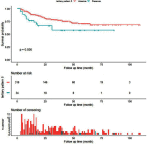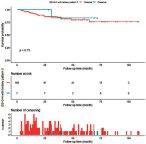Significance of tertiary Gleason pattern 5 in patients with Gleason score 7 after radical prostatectomy: a retrospective cohort study
- PMID: 31564900
- PMCID: PMC6731524
- DOI: 10.2147/OTT.S218001
Significance of tertiary Gleason pattern 5 in patients with Gleason score 7 after radical prostatectomy: a retrospective cohort study
Abstract
Purpose: To evaluate the association between tertiary Gleason pattern 5 (TGP5) and biochemical recurrence (BCR) in patients with prostate cancer (PCa) with a Gleason score (GS) of 7 after radical prostatectomy (RP).
Patients and methods: This retrospective study identified 350 patients who received RP and were graded as GS 7 (3+4 or 4+3) at the West China Hospital from January 2009 to December 2017. Initially, the patients were divided into two groups, TGP5 absence and TGP5 presence, independent of Gleason score. We further stratified the patients by adding the Gleason score into four groups: GS 3+4, GS 3+4/TGP5, GS 4+3, and GS 4+3/TGP5. Cox proportional-hazards models were used to evaluate the association between the status of TGP5 and BCR after adjusting for the confounding factors.
Results: The risk of BCR was significantly higher in patients with TGP5 when compared to patients without TGP5 (P=0.04, HR=2.17 95%, Cl: 1.03-4.59). For patients with primary Gleason pattern 4, the risk of BCR for patients with Gleason 4+3/TGP5 was statistically significantly higher than Gleason 4+3 (P=0.04, HR=2.45, 95% Cl: 1.04-5.76).
Conclusion: The TGP5 in patients with GS 7 had strong association with the risk of BCR and was an independent predictor for BCR. Further research on larger data sets is needed to confirm these findings.
Keywords: Gleason score; biochemical recurrence; prostate cancer; radical prostatectomy; tertiary Gleason pattern.
© 2019 Li et al.
Conflict of interest statement
The authors report no conflicts of interest in this work.
Figures



Similar articles
-
Oncologic outcomes of patients with Gleason score 7 and tertiary Gleason pattern 5 after radical prostatectomy.Korean J Urol. 2013 Sep;54(9):587-92. doi: 10.4111/kju.2013.54.9.587. Epub 2013 Sep 10. Korean J Urol. 2013. PMID: 24044091 Free PMC article.
-
The prognostic role of tertiary Gleason pattern 5 in a contemporary grading system for prostate cancer.Prostate Cancer Prostatic Dis. 2017 Mar;20(1):93-98. doi: 10.1038/pcan.2016.55. Epub 2016 Nov 15. Prostate Cancer Prostatic Dis. 2017. PMID: 27845330
-
Validation of tertiary Gleason pattern 5 in Gleason score 7 prostate cancer as an independent predictor of biochemical recurrence and development of a prognostic model.Urol Oncol. 2015 Feb;33(2):71.e21-6. doi: 10.1016/j.urolonc.2014.08.011. Epub 2014 Oct 23. Urol Oncol. 2015. PMID: 25443275
-
Tertiary Gleason pattern in radical prostatectomy specimens is associated with worse outcomes than the next higher Gleason score group in localized prostate cancer.Urol Oncol. 2018 Apr;36(4):158.e1-158.e6. doi: 10.1016/j.urolonc.2017.12.003. Epub 2017 Dec 27. Urol Oncol. 2018. PMID: 29288003
-
Primary Gleason grade and Gleason grade group at positive surgical margins: a systematic review and meta-analysis.BJU Int. 2021 May;127 Suppl 1:13-22. doi: 10.1111/bju.15316. BJU Int. 2021. PMID: 33973331
References
-
- Mottet N, Bellmunt J, Briers E, et al. EAU-ESTRO-SIOG guidelines on prostate cancer. Follow-up: after local treatment. Eur Urol. 2017;7(2):3. - PubMed
-
- Partin AW, Kattan MW, Subong EN, et al. Combination of prostate- specific antigen, clinical stage, and Gleason score to predict pathological stage of localized prostate cancer. A multi-institutional update. JAMA. 1997;277:1445–1451. - PubMed
LinkOut - more resources
Full Text Sources

